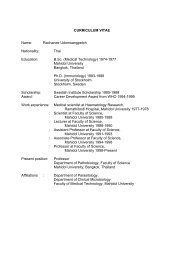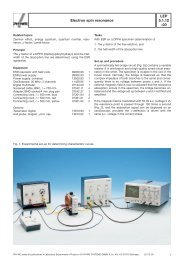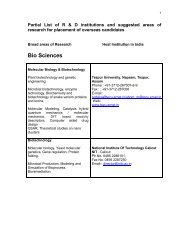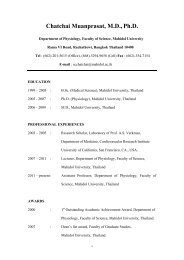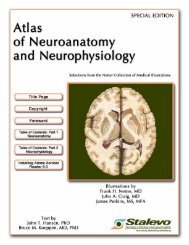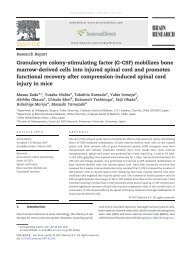SCBT 691-3: Biotechnology Seminar 1-3 2010 L.02 November 25 ...
SCBT 691-3: Biotechnology Seminar 1-3 2010 L.02 November 25 ...
SCBT 691-3: Biotechnology Seminar 1-3 2010 L.02 November 25 ...
Create successful ePaper yourself
Turn your PDF publications into a flip-book with our unique Google optimized e-Paper software.
<strong>SCBT</strong> <strong>691</strong>-3: <strong>Biotechnology</strong> <strong>Seminar</strong> 1-3 <strong>2010</strong><br />
<strong>L.02</strong> <strong>November</strong> <strong>25</strong> th , <strong>2010</strong> (9:00-12:00 A.M.)<br />
Speaker: Mr. Perapat Potinoun<br />
I.D. 5237144 <strong>SCBT</strong>/M<br />
Advisor: Dr. Nuttawee Niamsiri<br />
Title: Statistical Optimization and Culture Conditions for Growth and Polyhydroxybutyrate (PHB)<br />
Accumulation from Cassava Starch by Isolated Bacillus sp.<br />
Polyhydroxyalkanoates (PHAs) are a class of natural polymers that are produced by a wide variety<br />
of bacteria as their intracellular energy storage compounds. They are biodegradable and process similar<br />
material properties to various petrochemical-based plastics. However, its higher cost of production is still<br />
one of the important factors hampering the commercialization of PHAs. Thus, research on improving the<br />
productivity of PHAs from bacterial system is still needed in order to help reducing the overall PHAs<br />
production cost.<br />
Our main goals are to find suitable media compositions as well as culturing conditions for<br />
maximizing both cell growth and PHAs production from cassava starch by the PHA-producing bacteria of<br />
interest previously isolated in our laboratory. Thus far, four different Bacillus megaterium strains; S0-1,<br />
S1-2, S50-3 and S50-3 have been selected and studied for their growth profile as well as their PHB<br />
production capability. Thus far, S1-2 was found to be the best PHA producer that can produce<br />
polyhydroxybutyrate (PHB) up to 50% PHB content per cell dried weight with biomass of 4.5 g/L from<br />
glucose. Consequently, it was selected for the further studies for its growth and PHB production from<br />
various carbon substrates representing different stages of digested cassava starch; glucose, maltose, dextrin,<br />
liquefied starch, saccharified starch and gelatinized starch that were provided at the same C:N ratio. We<br />
found that S1-2 could produce PHB from the saccharified cassava starch better than liquefied and<br />
gelatinized cassava starch, resulting in similar biomass and %PHB content to pure glucose. Currently, the<br />
effect of different nitrogen source on growth and PHB production by S1-2 is investigated when provided<br />
together with the saccharified cassava starch. For the nitrogen source selection, ammonium sulfate and<br />
ammonium chloride gave the highest growth and PHB production among various nitrogen sources (i.e.<br />
ammonium chloride, ammonium sulfate, ammonium phosphate, ammonium nitrate and urea). Ammonium<br />
sulfate was selected, due to its less toxicity than ammonium chloride at high concentration. Then, other<br />
important media compositions and culturing conditions will then be optimized based upon statistical<br />
designed experiments using Plackett-burman design and response surface methodology in shake-flasks as<br />
well as in bioreactors.<br />
Reference: Speaker’s research work<br />
Speaker: Miss Naruwan Phenprom<br />
Advisor: Assoc. Prof. Dr. Apinya Assavanig<br />
I.D. 5237142 <strong>SCBT</strong>/M<br />
Title: Proteinase-producing halophilic lactic acid bacteria isolated from fish sauce fermentation and their<br />
ability to produce volatile compounds
Halophilic lactic acid bacteria were isolated from fish sauce mashes fermented at 1 to 12 months.<br />
Seven outof sixty-four isolates were selected according to their proteolytic activity and growth at <strong>25</strong>%<br />
NaCl for characterization and investigation of volatile compound production. All selected isolates were<br />
Gram-positive cocci with pairs/tetrads and grew at 0–<strong>25</strong>% NaCl, pH 4.5–9.0. Results of 16S rRNA gene<br />
sequence analysis showed 99% homology to Tetragenococcus halophilus ATCC 33315. The restriction<br />
fragment length polymorphism (RFLP) patterns of all isolates were also similar to those of T. halophilus<br />
ATCC 33315. These isolates were, thus, identified as T. halophilus. All isolates hydrolyzed fish protein in<br />
the medium containing <strong>25</strong>% NaCl. Intracellular aminopeptidase of 7 isolates exhibited the highest activity<br />
of 2.85–3.67 U/ml toward Ala-p-nitroanilide (Ala-pNA). T. halophilus strains MS33 and M11 showed the<br />
highest alanyl aminopeptidase activity (Pb0.05), and produced histamine in mGYP broth containing 5 and<br />
<strong>25</strong>% NaCl in the level of 6.62–22.55 and 13.14–20.39 mg/100 ml, respectively. Predominant volatile<br />
compounds of fish broth containing <strong>25</strong>% NaCl inoculated with T. halophilus MS33 and MRC5-5-2 were 1-<br />
propanol, 2-methylpropanal, and enzaldehyde, corresponding to major volatile compounds in fish sauce. T.<br />
halophilus appeared to play an important role in volatile compound formation during fish sauce<br />
fermentation.<br />
Reference:<br />
Udomsil, N., Rodtong, S., Tanasupawat , S., & Yongsawatdigul, J. (<strong>2010</strong>). Proteinase-producing<br />
halophilic lactic acid bacteria isolated from fish sauce fermentation and their ability to produce<br />
volatile compounds. International Journal of Food Microbiology, 141, 186–194.<br />
Speaker: Miss Onsaya Patanun<br />
I.D. 5237145 <strong>SCBT</strong>/M<br />
Advisor: Assoc. Prof. Dr. Jaranya Narangajavana<br />
Title: Genome-wide prediction and identification of microRNAs and their target genes in cassava<br />
In the past several decades, many studies have been discovered that microRNAs regulate various<br />
stages of development and physiological process in plants. Nevertheless, the miRNAs whose function<br />
involved in the switching from fibrous root to storage root are not yet known. To unravel miRNAs<br />
associated with storage root development, approximately 400 mature miRNAs sequences from Arabidopsis<br />
thaliana and Populus trichocarpa were used as query sequences to blast against the cassava genome in<br />
Phytozome database. All blast hits were further screened by using online Mfold program to analyze their<br />
secondary structure. At present, 13 potential miRNAs in cassava reported in MicroPC database were<br />
collected and also 10 miRNA were identified from the cassava genome. We totally collected 18 miRNA in<br />
cassava. Interestingly, we also found 5 new cassava miRNA, which are miR156, 160, 164, 167, and 396<br />
based on sequence homolog of the mature miRNA sequence. All miRNA target genes were also predicted.<br />
Some candidate miRNAs were further confirmed by using experimental approaches. The expression<br />
analysis of miRNAs and their target genes are in progress. The identified miRNAs should enable<br />
investigation of the role of miRNAs in storage root development. The better understandings of the miRNAs<br />
in storage root development would be beneficial in helping to develop cassava variety with desired<br />
properties.<br />
Reference: Speaker’s research work
Speaker: Miss Chattri Khomkrit<br />
I.D. 5237147 <strong>SCBT</strong>/M<br />
Advisor: Dr. Thipa Asvarak<br />
Title: Control of sheath blight disease in rice by thermostable secondary metabolites of Trichothecium<br />
roseum MML003<br />
Fungal plant diseases are the main major causes of crop production yield loss worldwide. Chemical<br />
fungicides are extensively used but human and an environment may have an affect from those chemicals<br />
too. Using antagonistic microorganism and its secondary metabolites to control plant diseases are friendlier<br />
and less toxic than chemical treatment, and are becoming a very interesting approach in the present. In this<br />
study Trichothecium roseum MML003 was investigated for biocontrol mechanisms against Rhizoctonia<br />
solani, rice sheath blight pathogen, both in vitro and in vivo experiments. On petri dish Trichothecium<br />
roseum MML003 inhibited growth of Rhizoctonia solani with an existing of a clear zone on GPYEA<br />
medium. The culture filtrates of Trichothecium roseum can inhibit mycelium growth and sclerotia<br />
formation and germination, indicating that bioactive activity is due to antibiotic production. Crude<br />
metabolites of Trichothecium roseum MML003 showed reduction of sheath blight disease in pot<br />
experiments. The crude antifungal metabolites were also characterized. Thus, this study provided evidence<br />
of using fungal bioactive metabolites to control plant disease.<br />
Reference:<br />
Jayaprakashvel, M., Selvakumar, M., Srinivasan, K., Ramesh, S., & Mathivanan, N. Control of sheath<br />
blight disease in rice by thermostable secondary metabolites of Trichothecium roseum MML003.<br />
European Journal of Plant Pathology, 126: 229–239.<br />
Speaker: Miss Porawee Pramoolkit<br />
I.D. 5237147 <strong>SCBT</strong>/M<br />
Advisor: Assoc. Prof. Dr. Jaranya Narangajavana<br />
Title: Expression and functional analyses of microRNA417 in Arabidopsis thaliana under stress<br />
conditions<br />
MicroRNAs (miRNAs) are 20-<strong>25</strong> nucleotides-long RNA transcripts that are capable of suppressing<br />
target gene expression by either mRNA cleavage or translational repression. Although many recent reports<br />
propose that miRNAs play diverse roles in growth, development, morphogenesis, and stress responses of<br />
plants, the biological roles of many miRNAs remain to be verified. Here, we investigated stress responsive<br />
expression patterns and functional roles of miRNA417 in seed germination and seedling growth of<br />
Arabidopsis thaliana under various abiotic stress conditions. miRNA417 was expressed constantly<br />
throughout the entire growth stages and ubiquitously in all organs including stems, roots, leaves, and<br />
flowers. The expression of miRNA417 was regulated by salt stress, dehydration stress, orabscisic acid<br />
treatment. To examine the biological roles of miRNA417 in stress responses, the transgenic Arabidopsis<br />
plants that constitutively overexpress miRNA417 under the control of cauliflower mosaic virus 35S<br />
promoter were generated, and their phenotypes were analyzed under stress conditions. Results showed that<br />
seed germination of the transgenic plants was retarded compared with the wild-type plants in the presence<br />
of high salt or abscisic acid. These results imply that miRNA417 plays a role as a negative regulator of<br />
seed germination in Arabidopsis plants under salt stress conditions.<br />
Reference:<br />
Jung, H.J., & Kang, H. (2007). Expression and functional analyses of microRNA417 in Arabidopsis<br />
thaliana under stress conditions. Plant Physiology and Biochemistry 45, 805-811.






